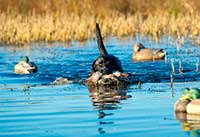(Provided by Michigan DNR)
 Check out Michigan's managed waterfowl areas for quality huntsHunters who have not been introduced to Michigan's Wetland Wonders - the DNR's managed waterfowl areas - have a unique opportunity to get to know five of them this year before duck season begins this fall. Open houses are scheduled for early October at the three Saginaw Bay areas, as well as at the Lake St. Clair and Lake Erie areas.
Check out Michigan's managed waterfowl areas for quality huntsHunters who have not been introduced to Michigan's Wetland Wonders - the DNR's managed waterfowl areas - have a unique opportunity to get to know five of them this year before duck season begins this fall. Open houses are scheduled for early October at the three Saginaw Bay areas, as well as at the Lake St. Clair and Lake Erie areas.
"The managed areas were really put together to provide high-quality waterfowl hunts in areas that would attract and hold ducks and geese," said Joe Robison, a wildlife biologist who supervises the five managed waterfowl areas in southeast Michigan. "That's what these areas were built for and that's what we're striving for.
"We manipulate water levels and provide balanced food sources," he continued. "We have crops of corn, buckwheat and millet, as well as good natural wild duck food - barnyard grass, wild millet and smartweed. And they're also all production areas, so we maintain prairie grass and nesting cover.
"You want to have a diversity of food, cover and water, and we've got that."
All managed waterfowl areas include refuge areas, where no hunting is allowed. Area managers conduct weekly surveys of refuges and post population estimates, as well as the habitat conditions, on the DNR website.
There is no fee for hunting at the managed areas. A base hunting license, a Michigan waterfowl hunting license and a federal waterfowl stamp are required. More information is available in the 2015 Michigan Waterfowl Digest [www.michigan.gov/documents/dnr/waterfowl_hunting_digest_465544_7.pdf).
All of the DNR's managed waterfowl areas hold drawings for hunting zones during prime waterfowl season, but each has its own unique set of rules. The open houses - which feature guided tours and question-and-answer sessions with area staff - will give hunters the information they need to enjoy a successful hunt at any of the areas.
The managed waterfowl areas (and their open house dates) include:
Shiawassee River State Game Area (Oct. 1)
A 10,000-acre area in Saginaw County that includes flooded crops, permanent marsh, river corridor and flooded woods, Shiawassee River adjoins a 9,800-acre federal refuge, which almost guarantees a large number of ducks in the area throughout the season. Hunts are held every morning and afternoon throughout the season. Last year hunters took 7,120 ducks and almost 1,000 geese at this area near St. Charles.
Fish Point State Wildlife Area (Oct. 5)
This 2,447-acre area located near Unionville in Tuscola County is the most heavily used by waterfowl hunters. It includes 1,200 acres of diked wetland, 720 acres of marsh refuge and 500 acres of crops. Last year hunters harvested nearly 7,000 ducks and 352 geese.
Nayanquing Point State Wildlife Area (Oct. 6)
The smallest (though perhaps most accessible to hunters without boats) of the managed waterfowl areas, this 1,500-acre area on the west shore of Saginaw Bay, just north of Linwood, features 66 hunts units. Nayanquing is open seven days a week, mornings and afternoons. Last year hunters took 2,644 ducks.
Harsens Island, the managed waterfowl area at St. Clair Flats State Wildlife Area (Oct. 7)
This 3,600-acre area on the upper end of Lake St. Clair is accessed by ferry from Algonac. There are two marsh units in addition to the flooded cropland. The area has more than 80 zones for waterfowl hunting and is open seven days a week with morning and evening drawings. Last year hunters bagged 9,000 ducks and 128 geese.
Point Mouillee State Game Area (Oct. 8)
At 4,040 acres in Wayne and Monroe counties, Point Mouillee is one of the largest freshwater marsh restorations in America. The actual managed hunting area can accommodate only 26 parties - in marsh or crops -but there are excellent marshes that offer open hunting with no drawings or permits required. Hunting at the managed areas takes place Tuesday mornings and Thursdays and Sundays, mornings and evenings. Last year hunters harvested 1,090 ducks at the managed units, but, Robison said, "We get four times that many on the non-managed areas."
All open houses begin at 6 p.m.
In addition, the Department of Natural Resources operates two managed waterfowl areas on the west side of the state: the Fennville Farm Unit of the Allegan State Game Area and the Muskegon County Wastewater Goose Management Unit. Both are largely Canada goose hunting areas.
Last year hunters took 1,159 geese at Fennville, which is open five mornings and two afternoons a week throughout the 92-day goose hunting season without managed drawings. Muskegon, which, unlike the other areas is actually a county-owned facility where hunting takes place on agricultural fields, is open Tuesday mornings and Saturday mornings and afternoons. Last year hunters harvested 100 geese at Muskegon. The season at Muskegon begins Oct. 17.
Hunters who visit at least three of these managed waterfowl areas during the season are eligible for prizes as part of the DNR's Wetlands Wonder Challenge, a hunting contest highlighting the exceptional waterfowl hunting opportunities available to the public at these locations. The challenge takes place at the seven areas throughout southern Michigan and will run Oct. 10 through Jan. 31. Seven winners will be chosen Feb. 15. To be entered for the grand-prize drawing, hunters must hunt at three of the seven managed waterfowl hunting areas. Hunters who hunt all seven areas will win a prize.




